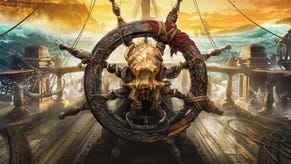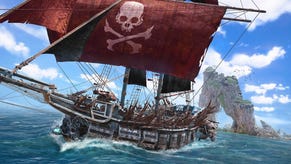Skull and Bones review - entertaining combat can't save a lifeless pirate adventure
Frayed knot.
Pirates! Such an evocative word! But if it's swashbuckling tales of derring-do you're after, of sea monsters and high seas adventuring, of buried treasures on distant shores and smuggling escapades by the light of the moon, there are other, better ways to fulfil that classic pirate fantasy, because Skull and Bones' take is, regrettably, a bit of a bore.
It begins, though, as all good adventures often do, in the midst of battle, wood splintering and canons booming as your ship is pursued across the 17th century Indian Ocean by a British armada intent on delivering you to Davy Jones - a wonderfully cinematic opener slightly undone by the fact straying beyond an arbitrary boundary immediately presents you with a stroppy message to turn around. Fortune, though, is on your side, and you escape - after bobbing through shark-infested waters on a bit of flotsam - with the shirt on your back, a rickety old dhow, and a burning ambition to become the most renowned pirate in all the land.
In rather less romantic terms, it's a live-service progression track grind masquerading as a rags-to-riches story, but it's one that Skull and Bones, to its credit, tries really hard to sell. Over its near-decade of development and across countless iterations, Ubisoft's pirate adventure has doubtless taken many forms, but what I wasn't expecting to find - amid its live-service trappings and its flexible fusion of drop-in co-op and optional PvP - was quite such a lengthy, narrative-driven campaign. Granted, its story - a self-serious, by-the-numbers tale of factional warfare, populated by a cast of largely charmless characters that could have been wrenched from any number of blockbuster Ubisoft games - isn't a particularly engaging one, but it does at least give Skull and Bones' rather graceless tangle of underlying systems some narrative drive.
Your journey from destitute castaway to the mightiest pirate is, ultimately, one of glacial XP accruement and the ponderous tick of a progression bar, driven by a level-gated crafting system and an endless resource-gathering grind. It's a set-up that, truthfully, feels more grocery delivery driver than pirate a lot of the time, and it's a thematic mismatch Skull and Bones, for all its tricornes and shanties, never quite resolves. But still, the underlying acquisition loop does what it's supposed to, providing a reasonable enough excuse to raise anchor and move.
Resources, of which there are many, ranging from raw materials to valuable commodities, are found at settlements and outposts, sometimes plucked from the edge of a landmass by means of a timing-based mini-game so arbitrary you can turn it off in the menu, or by sinking ships travelling along specific trade routes - all of which you'll first need to reveal by exploring the map. And once specific resources have been acquired, your next task is to whisk them safely back to home where (provided you've found the relevant blueprint, as if the process wasn't drawn-out enough already) you can craft a bigger boat, a beefier cannon, better tools, enabling you to chart deadlier waters, acquire different resources, craft fancier stuff, and on it goes.

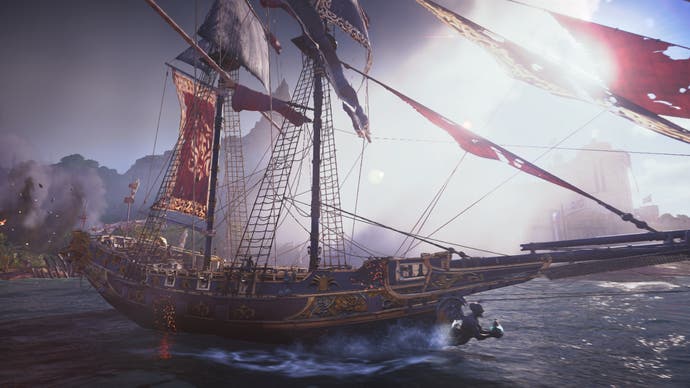
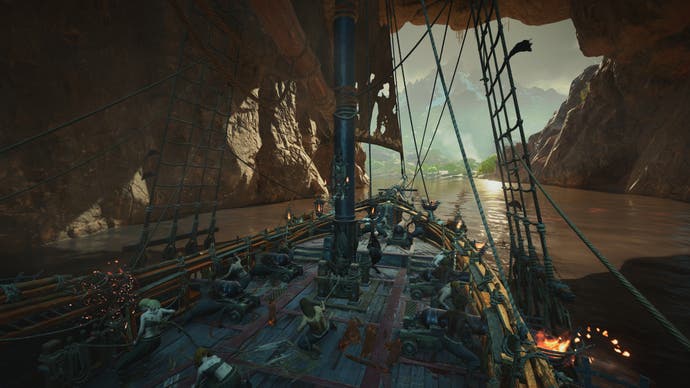

Skull and Bones makes some genuine effort to add variety to its acquisition loop. Sometimes you'll face off against a powerful fleet or take on a fearsome pirate bounty with a massive health pool. Sometimes you'll want to plunder a settlement for a particular resource, whereupon you'll need to fend off waves of incoming vessels until a timer reaches zero. But variation means little without a rock-solid foundation, and it's here, in its two most fundamental components - sailing and ship-to-ship combat - that Skull and Bones flounders.
Ship-to-ship combat, thankfully, is a hoot and a high point, a frenetic burst of elegantly streamlined chaos that makes up for its limited depth with pure cinematic panache. As combat begins - something that, when dealing with AI ships, only happens if you initiate an attack or cause enough of a nuisance that, GTA-style Wanted meter aglow, other ships want to pick a fight with you - your perspective shifts to a deck-level view of your boat split into four quadrants. Any weapon you've crafted can be assigned to any quadrant before leaving an outpost (the exact number of available quadrants depends on your current ship's class), and you can take immediate control of a weapon during combat simply by looking at it.
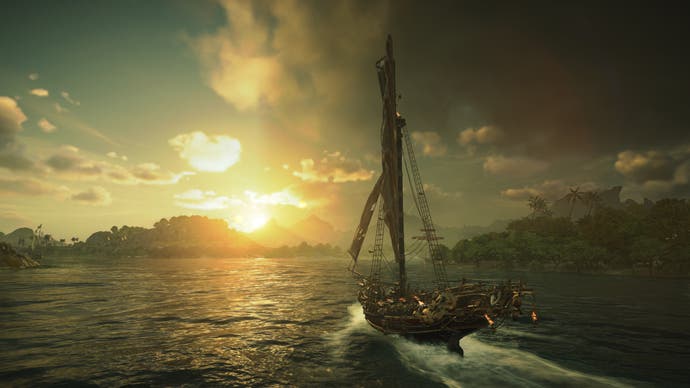


There's an engagingly broad palette for experimentation when it comes to armaments in Skull and Bones, with classic cannons nudging up against the likes of torpedoes, mortars, ballistae, even sea fire - each, in turn, capable of inflicting distinct damage types and status effects, all necessitating a certain degree of counter-play. The basic rhythm of battle, though, is brutally straightforward: you swivel to select a weapon, fire, then, while waiting for it to reload, swing to another quadrant to unleash your next available attack - all while simultaneously manoeuvring your vessel to ensure your target remains in the firing line.
There are some weird omissions - a boarding mechanic shorn of melee combat makes for some jarringly anticlimactic fade-to-black battle resolutions - but the sheer visceral thrill of Skull and Bones' combat is undeniable as your vessel pitches and yaws on violent, crashing waves, and the world comes alive amid screams, smoke, cannon fire, and sea spray. It's delivered with a level of cinematic bluster that still manages to grip even dozens of hours in, but it's also a fleeting, superficial kind of high with steadily diminishing returns. Skull and Bones leans far too heavily on a combat system whose showiness is no real substitute for tactical depth, and which simply isn't robust enough to offset the game's more critical flaws.
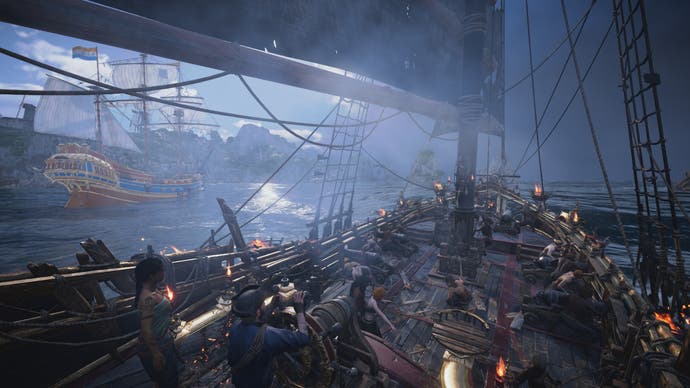
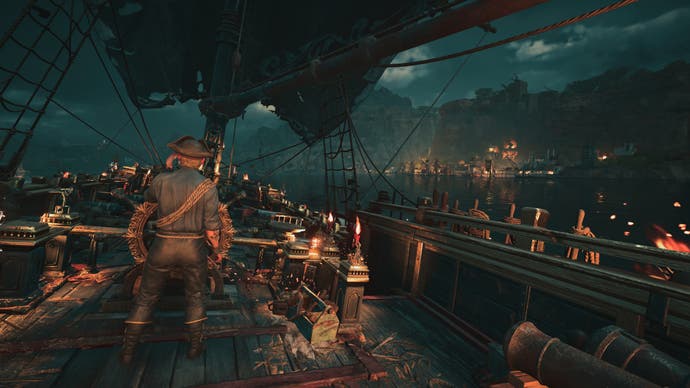
The world Ubisoft has created for Skull and Bones is a genuinely beautiful one, a vast open ocean of vibrant tropical vistas, ramshackle shanty towns, sprawling African savannah, and craggy spires. It’s also a world alive with merchant ships plying their trade, pirates - of both the NPC and player variety - unleashing carnage upon the waves; where storms rage, mists rise, whales sing, and the landscape beguiles in the golden light of a new day. Artistically, it's endlessly arresting, but practically, it's nothing more than a shell, a backdrop, a void.
For the majority of your time in Skull and Bones, you're not really a pirate, you’re a boat, functionally at least, and only a miniscule number of locations across Ubisoft's striking world afford the opportunity to disembark, stretch your legs, and explore. These outposts - differing from the handful of 'home' outposts that offer the full gamut of core crafting and upgrade amenities - are beautiful, lavish things; vast stretches of stunning environmental artistry encompassing everything from secluded lagoons surrounded by hundred-foot-tall waterfalls to enchanting settlements hidden high above swamps in the bows of mangrove trees. They're also utterly wasted - huge expanses of scenery devoid of any meaningful utility aside from an interactive cooking pot, a bottomless storage cache to offload your cargo, and a couple of traders - and if anything speaks of Skull and Bones' troubled development it's these bizarre follies. Whatever happened behind the scenes, Ubisoft's slick blockbuster patch-up does a surprisingly thorough job of papering over the cracks. But outposts, in all their conspicuous emptiness, feel like the remnants of some grand ambition forever unrealised.


And confined to your boat for as long as you are, Skull and Bones really needs to nail the thrill of traversal - but, of all the things to flub in a pirate game, its sailing is dull to the point of disaster. It doesn't help that Skull and Bones' 17th century vessels don't feel much like boats at all - there's so little sense of weight or physicality or presence to them, you might as well be piloting an ice cream van over the waves - but worse, traversal is streamlined to such a degree your role often feels more like chaperone than a required presence. Essentially, you just point your boat at your destination and wait, re-engaging every now and then for some minor course correction; you'll occasionally flick the stick to counter Skull and Bones' almost apologetically forgiving environmental hazards - the gentle nudge of a wave or gust of wind - and you'll intermittently raise your sail. Not because colliding with the environment does anything but minimal damage, but because going full speed for too long exhausts your crew's stamina level.

There are times this heavily reductive approach fits - traversing the winding waterways of Africa or ploughing through a raging storm provides enough navigational busywork to keep things interesting - but out on the vast oceanic expanse of Skull and Bones' needlessly large map, when new ports can be dozens of minutes away and the only distraction is yet another ship to launch a volley of cannon balls at, your limited involvement is tedious in the extreme. Sea of Thieves - that other pirate game - offers an interesting contrast, building its own oceanic travel around a series of moment-by-moment actions designed to keep you constantly engaged. Sails need to be adjusted to manage turning speed, or angled to catch the wind, water needs to be bucketed from below deck and holes repaired, while the constant buffeting of waves means it’s impossible to leave the wheel unattended for too long. It's a distinctly hands-on approach that keeps you connected to your ship, keeps you present in its world - whereas the fact I managed to take some lengthy notes without too much incident while ferrying back and forth in Skull and Bones speaks volumes about its interminably unengaging traversal.
And that's the rub. Skull and Bones isn't, I don't think, an inherently bad game - it's certainly far from the disaster its ten-year development had many bracing for - but too often it simply isn't a very interesting one. There are moments when Skull and Bones weaves a convincing spell. Cannon balls flying in ship-to-ship combat, impromptu engagements with other players, the brief dopamine rush when a resource slog culminates in a shiny new toy, or even when the light hits just right on another glorious view. But it's soon swept away on a tide of uninspiring fetch quests and tedious traversal that just can't sustain its live-service grind. Skull and Bones is okay, fine even, on rare occasions maybe even great - but, ultimately, it comes down to this: no game, let alone a swashbuckling pirate adventure, should be so consistently dull.
A copy of Skull and Bones was provided for review by Ubisoft.


